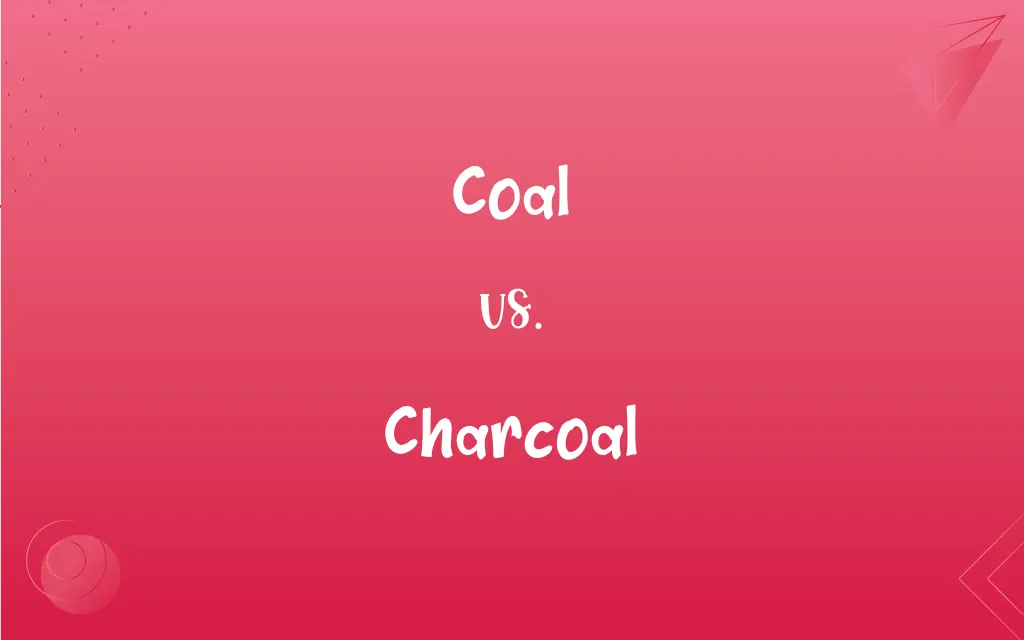Coal vs. Charcoal: What's the Difference?
Edited by Janet White || By Harlon Moss || Updated on October 16, 2023
Coal is a black or brownish-black sedimentary rock, while charcoal is black carbon residue from pyrolysis of organic materials.

Key Differences
Coal and charcoal are both carbon-rich substances, but they differ in origin and use. Coal is a natural mineral that is formed over millions of years from the remains of plants and animals. It is mined from beneath the earth's surface and is a primary source of energy in many parts of the world.
Charcoal, on the other hand, is produced by the controlled burning of wood or other organic materials in the absence of oxygen. The process removes water and other volatile compounds, leaving behind a black, porous form of carbon. This carbon-rich material is used for various purposes, from grilling food to producing art.
Coal is categorized based on its carbon content and energy value. There are different types, such as anthracite, bituminous, and lignite coal. These types indicate the coal's maturity, with anthracite being the hardest and highest in carbon content. Charcoal does not have such classifications and is typically recognized by its use, such as activated charcoal used for filtration.
In terms of environmental impact, burning coal releases more greenhouse gases than burning charcoal. This is because coal contains impurities that produce harmful emissions when combusted. Charcoal, while cleaner than coal, still produces carbon dioxide but in lesser amounts.
Coal has been a pivotal driver in industrial revolutions and continues to power industries and homes. Charcoal, with its versatility, finds its place not just in industries but also in households, especially in barbeques and artistry.
ADVERTISEMENT
Comparison Chart
Origin
Formed from ancient plant and animal remains
Produced by burning organic materials
Usage
Primary energy source
Grilling, art, filtration
Classification
Types include anthracite, bituminous, lignite
No specific classification
Environmental Impact
Releases more greenhouse gases
Produces lesser emissions compared to coal
Texture
Hard, rocky
Black, porous
ADVERTISEMENT
Coal and Charcoal Definitions
Coal
Coal is a fossil fuel formed from ancient plant and animal remains.
The power plant primarily uses coal to produce electricity.
Charcoal
Charcoal is used extensively for grilling.
The chef uses charcoal to impart a smoky flavor to the dishes.
Coal
Coal has been a primary energy source for centuries.
The industrial revolution was fueled by coal-driven machines.
Charcoal
Charcoal can be produced by burning wood in the absence of oxygen.
Traditional methods of making charcoal involve slow burning in clay ovens.
Coal
Coal is a sedimentary rock with carbon and other elements.
The coal industry plays a major role in the country's economy.
Charcoal
Charcoal has various industrial and household applications.
Charcoal tablets are sometimes used for digestive issues.
Coal
Coal is mined from beneath the Earth's surface.
The mining town thrived due to the abundant coal deposits.
Charcoal
Charcoal is black carbon residue obtained from pyrolysis of organic materials.
Many artists prefer charcoal for sketching due to its versatility.
Coal
Coal is classified into types like anthracite and bituminous based on maturity.
Anthracite coal is known for its high carbon content.
Charcoal
Charcoal is known for its porous nature.
Activated charcoal filters are popular in water purification.
Coal
A natural dark brown to black graphitelike material used as a fuel, formed from fossilized plants and consisting of amorphous carbon with various organic and some inorganic compounds.
Charcoal
A black, porous, carbonaceous material, 85 to 98 percent carbon, produced by the destructive distillation of wood and used as a fuel, filter, and adsorbent.
Coal
A piece of this substance.
Charcoal
A drawing pencil or crayon made from this material.
FAQs
What is coal primarily used for?
Coal is primarily used as an energy source for electricity generation.
Which releases more greenhouse gases, coal or charcoal?
Coal releases more greenhouse gases compared to charcoal.
How is charcoal made?
Charcoal is made by burning organic materials in the absence of oxygen.
Is coal a type of rock?
Yes, coal is a sedimentary rock.
Can you use charcoal for cooking?
Yes, charcoal is commonly used for grilling.
Are there different types of coal?
Yes, coal is classified into types like anthracite, bituminous, and lignite.
Is activated charcoal different from regular charcoal?
Yes, activated charcoal is processed to increase its porosity and absorption capacity.
Which type of coal has the highest carbon content?
Anthracite coal has the highest carbon content.
Is burning coal harmful to the environment?
Yes, burning coal releases harmful greenhouse gases and other pollutants.
Can you make charcoal at home?
While possible, making charcoal at home requires controlled conditions and is not commonly done.
What gives charcoal its black color?
The carbon residue from the pyrolysis process gives charcoal its black color.
How has coal impacted industrialization?
Coal has been a primary driver of industrial revolutions, powering industries and machinery.
What is the texture of coal?
Coal has a hard, rocky texture.
Are there environmental concerns with using charcoal?
While cleaner than coal, burning charcoal still releases carbon dioxide and can lead to deforestation if not sourced sustainably.
Why is charcoal preferred for barbeques?
Charcoal imparts a distinct smoky flavor and can reach high temperatures, making it preferred for barbeques.
Is charcoal used in art?
Yes, charcoal is popularly used for sketching in art.
Where is coal found?
Coal is found beneath the Earth's surface and is mined.
How does charcoal purify water?
Charcoal's porous nature allows it to absorb impurities, making it suitable for water purification.
How long has coal been used as an energy source?
Coal has been used for centuries, particularly since the industrial revolution.
Can charcoal be used for medicinal purposes?
Yes, activated charcoal is sometimes used in medicine to absorb toxins.
About Author
Written by
Harlon MossHarlon is a seasoned quality moderator and accomplished content writer for Difference Wiki. An alumnus of the prestigious University of California, he earned his degree in Computer Science. Leveraging his academic background, Harlon brings a meticulous and informed perspective to his work, ensuring content accuracy and excellence.
Edited by
Janet WhiteJanet White has been an esteemed writer and blogger for Difference Wiki. Holding a Master's degree in Science and Medical Journalism from the prestigious Boston University, she has consistently demonstrated her expertise and passion for her field. When she's not immersed in her work, Janet relishes her time exercising, delving into a good book, and cherishing moments with friends and family.































































